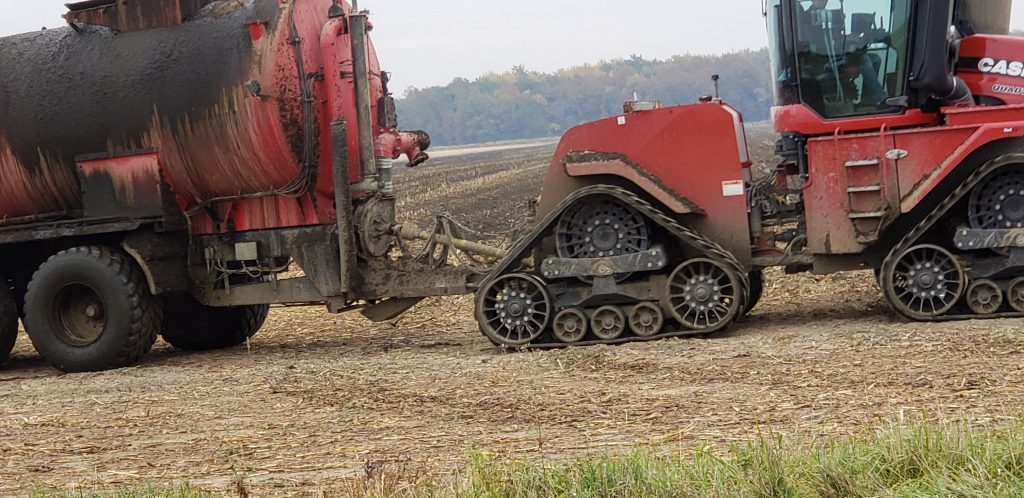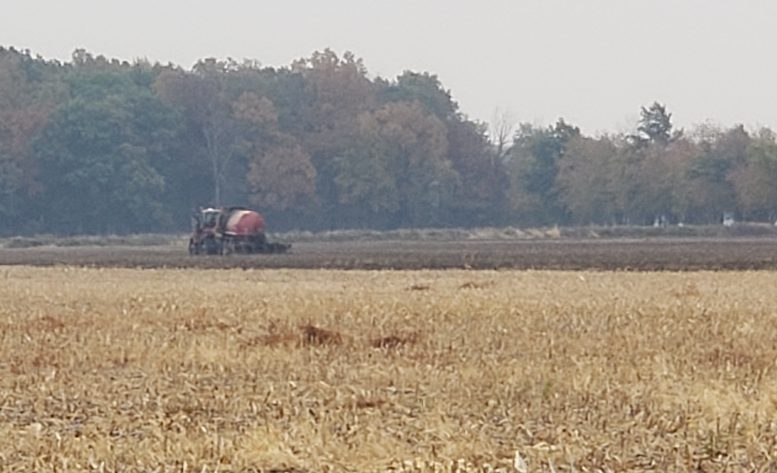By JAN LARSON McLAUGHLIN
BG Independent News
When it rains, it pours – and some Lake Erie advocates want to make sure isn’t not manure that’s pouring into ditches and making its way to the lake.
Vickie Askins is one of those people who keeps her eyes on manure from large animal farms being applied to farm fields. Last week, as the weather forecasts predicted more than one inch of rain, Askins received calls about three of the four large dairies in Wood County spreading manure on fields.
The calls come from neighbors of the fields, or in some cases from school bus drivers who take note of the manure tankers on the roads, Askins said.
These Concentrated Animal Feeding Operations are all in the western Lake Erie basin, she said.
So Askins headed out with her camera, and got photographs of haulers applying manure from the Reyskens Dairy near Custar to the surface of fields. According to Askins, there was already liquid standing in the field between the rows before the liquid manure was added.

According to the Associated Press, the harmful algae bloom on Lake Erie this past summer was the fifth largest since researchers began ranking them going back to 2002.
The National Oceanic and Atmospheric Administration reported the bloom covered about 700 square miles by the end of August.
Algae blooms have been a persistent problem on the western end of Lake Erie, the shallowest and warmest of the Great Lakes. They’ve caused numerous water warnings and beach closings in recent years.
Five years ago, a toxic bloom caused a two-day shutdown of Toledo’s drinking water.
Studies have shown that much of the phosphorus that fuels the algae comes from fertilizer runoff from farm fields along with sewage treatment plants and other sources.
Less commercial fertilizer was used on farm fields this year because many fields went unplanted due to heavy spring rains. However, manure from the CAFOs still has to be spread when the manure lagoons get full.
“The animals still produce manure every day,” Askins said.
The Ohio Revised Code forbids surface application of manure when the local weather forecast calls for a greater than 50 percent chance of precipitation over one-half inch in a 24-hour period.
Askins said she called the EPA Hotline last week and someone from the BG office noted her complaint. He said he had contacted the Ohio Department of Agriculture and asked that agency to call the dairy to cease applying any more manure.
The ORC states that those rules don’t apply if the manure is injected into the ground or if it’s applied onto a growing crop.
However, this manure was not being injected into the ground, nor was it plowed under, Askins said. It was not placed on a “growing crop” and the heavy rain made it doubtful that it stayed on the field rather than flowed to a nearby ditch.
Last month, manure from a CAFO in Mercer County was blamed for a fish kill there. Mercer Soil and Water Conservation District officials identified MVP Dairy, a 4,200-head operation, as the source of the manure pollution incident.
Those investigating that incident reported a moderate number of fish in the ditch appeared to have been dead for a few days. The ditch is in the western Lake Erie basin.
“It was just really sad,” Askins said of the fish kill. “It was a huge mess.”
She worries the same fate is possible for an endangered fish identified near the Reyskens Dairy in Wood County. The fish – called the Western Banded Killifish – is found in just two places in Ohio and nearly stopped the dairy from getting a permit to locate there.
“That’s where this field drains,” Askins said of the ditch where the fish have been found.

